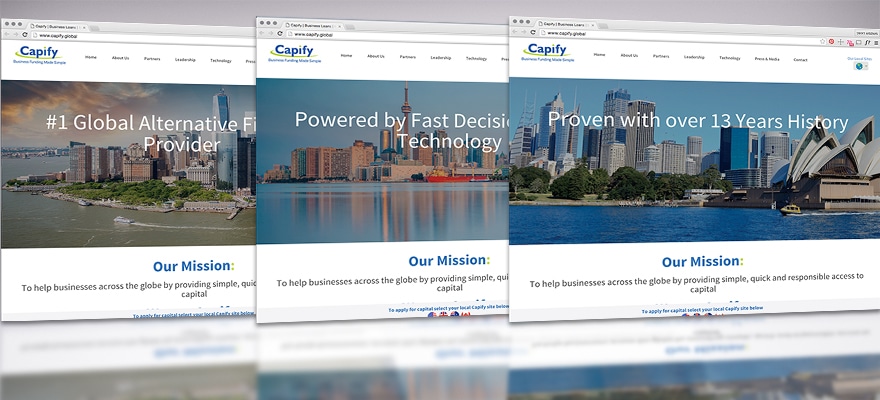Before online lending became a ‘thing’ with the proliferation of marketplace lenders and venture funds investing billions of dollars into the Fintech sector, a small group of early adopter firms have offering small business and personal loans using online platforms since the early 2000’s. In today’s Fintech Spotlight, we take a look at Capify and their evolution and growth as an online lender since the company’s launch in 2002.
Differing from many of the current fintech startups dominating the online lending space and utilize marketplace models, Capify has historically serviced borrowers from its own balance sheet. As such, loan risk is covered by Capify and not passed on to external lenders.
In this regard, Capify is similar to banks that source capital for loans from their own balance sheet. However, unlike banks, by focusing exclusively on lending and leveraging technology, online lenders are able to operate more efficiently and provide more attractive rates to borrowers.
Capify CEO David Goldin explained that as a result of the overheads that burden banks, there are many smaller loan types that are unprofitable for them with him: “banks can’t make money on unsecured loans below $100,000”. As such, this nuance has provided an opportunity for Capify and others to service an oft neglected segment of borrowers by banks and offer them a streamlined and efficient lending process.
Unifying brands and launching a marketplace
Having launched in the US in 2002, Capify began to service Canadian borrowers in 2008 and expanded to Australia and the UK in 2009. However, as the firm expanded, Capify elected to do so using different brands in the four regions. The model contrasts to that of current practices in the industry where firms tend to use the same brand across multiple regions. With the growing awareness of alternative online lenders among businesses, Capify made the decision to unify its brands under the Capify name in 2015.
Another change taking place in 2016 is the launch of an online loan marketplace. Operating alongside its balance sheet based lending business, the P2P loan marketplace will provide an opportunity for external investors to participate in Capify’s deal flow from borrowers.
Changing rates
Beyond brand unification, arguably one of the most important events currently affecting the lending sector is the potential for further rate hikes. Beginning last December, the Fed raised rates for the first time since 2006. For lenders, higher rates mean rising interest rates charged to customers as well as increasing costs of capital and higher default rates.
According to Goldin, beyond just adjusting for changing interest rates, there is a greater impact that lenders have to be aware of. Goldin explained that the “theory is that as rates rise an economy slows down”. Therefore, lenders don’t only have to worry about rising default rates, but that a slower economy may reduce demand for loans.
For Capify, Goldin said that he believed having a global client base is a solution for changing rates. He explained that through diversification, Capify is able to be less exposed to credit cycle changes in any single region.
Competition and partnerships
Unlike in 2002 or even 2009, Capify finds itself now with a much more competitive environment than it has in the past. Among the offshoots of competition is rising acquisition costs for new customers which had led to many alternative lenders partnering with banks.
Goldin described partnerships as “not a new line of business”, but one that is evolving with a new class of alternative lenders. According to Goldin, for banks, the rationale behind partnerships are costs due to their lack of ability to profitably service smaller size loans. Referring customers to smaller and more efficient alternative lenders provides them with a revenue stream for these clients that they wouldn’t otherwise support.
On the other hand, lenders are able to Leverage partnerships with banks or other providers of services to small business to decrease their acquisition costs. For the current climate, Goldin stated that “partnerships make sense since CPAs (cost per acquisition) have been rising for companies”.
In relation to companies that were emerging as competitors to lenders, Goldin cited PayPal and Square. Offering services to small and medium businesses, both firms are able to grab market share by upselling business loans to their customers and are examples as non-traditional lenders creating more competition in the sector.
Timing vs technology
Goldin described that despite the digitalization of lending having evolved the sector, more than technology, success in lending is about timing. Goldin stated that “the average small business owner doesn’t care about technology”. However, Goldin explained that what they care about “is the speed of the process and rates”. As such, this benefits companies like Square and PayPal that are already being used by many small and medium sized businesses and are able to be visibly present when their borrowing needs arrive.
The bottom line is that Goldin summarized that “lending capital is a timing product”. Therefore, Goldin explained that for Capify, its aim is to use its experience to understand how to reach businesses at the point that they are in need of capital and then provide the borrowing process as easily and quickly as possible.
Fintech Spotlight is a new column on Finance Magnates devoted to reviewing innovative financial technology companies and sector trends.

















